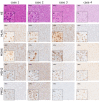Influence of MMR, MGMT Promotor Methylation and Protein Expression on Overall and Progression-Free Survival in Primary Glioblastoma Patients Treated with Temozolomide
- PMID: 37047153
- PMCID: PMC10094528
- DOI: 10.3390/ijms24076184
Influence of MMR, MGMT Promotor Methylation and Protein Expression on Overall and Progression-Free Survival in Primary Glioblastoma Patients Treated with Temozolomide
Abstract
Glioblastoma is the most common malignant brain tumor in adults. Standard treatment includes tumor resection, radio-chemotherapy and adjuvant chemotherapy with temozolomide (TMZ). TMZ methylates DNA, whereas O6-methylguanine DNA methyltransferase (MGMT) counteracts TMZ effects by removing the intended proteasomal degradation signal. Non-functional MGMT mediates the mismatch repair (MMR) system, leading to apoptosis after futile repair attempts. This study investigated the associations between MGMT promoter methylation, MGMT and MMR protein expression, and their effect on overall survival (OS) and progression-free survival (PFS) in patients with glioblastoma. MGMT promoter methylation was assessed in 42 treatment-naïve patients with glioblastoma WHO grade IV by pyrosequencing. MGMT and MMR protein expression was analyzed using immunohistochemistry. MGMT promoter methylation was present in 52%, whereas patients <70 years of age revealed a significantly longer OS using a log-rank test and a significance threshold of p ≤ 0.05. MGMT protein expression and methylation status showed no correlation. MMR protein expression was present in all patients independent of MGMT status and did not influence OS and PFS. Overall, MGMT promoter methylation implicates an improved OS in patients with glioblastoma aged <70 years. In the elderly, the extent of surgery has an impact on OS rather than the MGMT promoter methylation or protein expression.
Keywords: MGMT promoter methylation; MGMT protein expression; glioblastoma; immunohistochemical analysis; mismatch repair; temozolomide.
Conflict of interest statement
The authors declare no conflict of interest.
Figures



Similar articles
-
Long-term therapy with temozolomide is a feasible option for newly diagnosed glioblastoma: a single-institution experience with as many as 101 temozolomide cycles.Neurosurg Focus. 2014 Dec;37(6):E4. doi: 10.3171/2014.9.FOCUS14502. Neurosurg Focus. 2014. PMID: 25434389
-
Epigenetic Activation of TUSC3 Sensitizes Glioblastoma to Temozolomide Independent of MGMT Promoter Methylation Status.Int J Mol Sci. 2023 Oct 14;24(20):15179. doi: 10.3390/ijms242015179. Int J Mol Sci. 2023. PMID: 37894860 Free PMC article.
-
MGMT promoter methylation in patients with glioblastoma: is methylation-sensitive high-resolution melting superior to methylation-sensitive polymerase chain reaction assay?J Neurosurg. 2019 Mar 1;130(3):780-788. doi: 10.3171/2017.11.JNS171710. Epub 2018 May 4. J Neurosurg. 2019. PMID: 29726772
-
Prognostic value of test(s) for O6-methylguanine-DNA methyltransferase (MGMT) promoter methylation for predicting overall survival in people with glioblastoma treated with temozolomide.Cochrane Database Syst Rev. 2021 Mar 12;3(3):CD013316. doi: 10.1002/14651858.CD013316.pub2. Cochrane Database Syst Rev. 2021. PMID: 33710615 Free PMC article.
-
The prognostic value of MGMT promoter methylation in glioblastoma: A meta-analysis of clinical trials.J Cell Physiol. 2018 Jan;233(1):378-386. doi: 10.1002/jcp.25896. Epub 2017 May 16. J Cell Physiol. 2018. PMID: 28266716 Review.
Cited by
-
The DNA Alkyltransferase Family of DNA Repair Proteins: Common Mechanisms, Diverse Functions.Int J Mol Sci. 2023 Dec 29;25(1):463. doi: 10.3390/ijms25010463. Int J Mol Sci. 2023. PMID: 38203633 Free PMC article. Review.
-
Beyond the Promoter: Total MGMT Gene Methylation Modulates Response to DNA Alkylating Agents in Glioma.Mol Cancer Ther. 2025 Jun 4:10.1158/1535-7163.MCT-24-0977. doi: 10.1158/1535-7163.MCT-24-0977. Online ahead of print. Mol Cancer Ther. 2025. PMID: 40464417
-
Insights into the regulatory role of RNA methylation modifications in glioma.J Transl Med. 2023 Nov 14;21(1):810. doi: 10.1186/s12967-023-04653-y. J Transl Med. 2023. PMID: 37964279 Free PMC article. Review.
-
Molecular Profile as an Outcome Predictor in Glioblastoma along with MRI Features and Surgical Resection: A Scoping Review.Int J Mol Sci. 2024 Sep 8;25(17):9714. doi: 10.3390/ijms25179714. Int J Mol Sci. 2024. PMID: 39273661 Free PMC article.
-
MGMT epimutations and risk of incident cancer of the colon, glioblastoma multiforme, and diffuse large B cell lymphomas.Clin Epigenetics. 2025 Feb 20;17(1):28. doi: 10.1186/s13148-025-01835-x. Clin Epigenetics. 2025. PMID: 39980037 Free PMC article.
References
-
- Abd-Elghany A.A., Naji A.A., Alonazi B., Aldosary H., Alsufayan M.A., Alnasser M., Mohammad E.A., Mahmoud M.Z. Radiological Characteristics of Glioblastoma Multiforme Using CT and MRI Examination. J. Radiat. Res. Appl. Sci. 2019;12:289–293. doi: 10.1080/16878507.2019.1655864. - DOI
-
- Stupp R., Hegi M.E., Mason W.P., van den Bent M.J., Taphoorn M.J.B., Janzer R.C., Ludwin S.K., Allgeier A., Fisher B., Belanger K., et al. Effects of Radiotherapy with Concomitant and Adjuvant Temozolomide versus Radiotherapy Alone on Survival in Glioblastoma in a Randomised Phase III Study: 5-Year Analysis of the EORTC-NCIC Trial. Lancet Oncol. 2009;10:459–466. doi: 10.1016/S1470-2045(09)70025-7. - DOI - PubMed
-
- Hegi M.E., Liu L., Herman J.G., Stupp R., Wick W., Weller M., Mehta M.P., Gilbert M.R. Correlation of O6-Methylguanine Methyltransferase (MGMT) Promoter Methylation with Clinical Outcomes in Glioblastoma and Clinical Strategies to Modulate MGMT Activity. J. Clin. Oncol. 2008;26:4189–4199. doi: 10.1200/JCO.2007.11.5964. - DOI - PubMed
MeSH terms
Substances
Grants and funding
LinkOut - more resources
Full Text Sources
Medical
Research Materials

